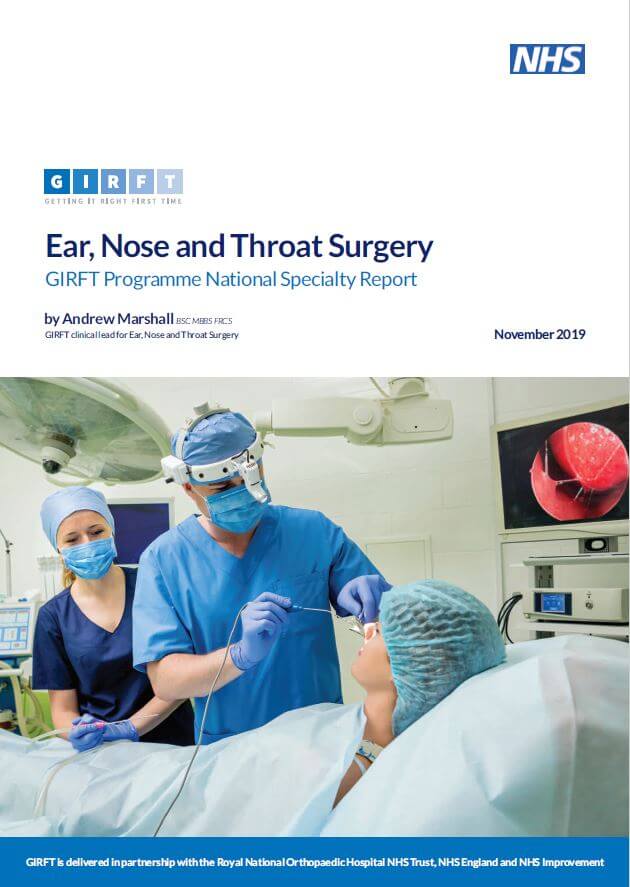
Andrew Marshall, a Consultant ENT Surgeon at Nottingham University Hospitals NHS Trust, visited 126 departments across England before publishing his recent ENT surgery national report for the Getting It Right First Time (GIRFT) programme. Here, he explains how identifying unwarranted variation and sharing good practice could bring improvements in patient care and free-up £33m a year for the NHS.
One hundred and twenty-six ENT units - that’s a whole lot of service station sandwiches and buffet car coffee along the way. There were times when visiting trusts for my GIRFT national review of ENT surgery felt like an endless road trip. From Northumberland down to Cornwall over the course of two years, I saw far more roadworks (and much less of my family) than I would have liked.
But, of course, with the benefit of hindsight, it was worth every mile. I joined the GIRFT team because of my passion for service improvement, and the delivery of ENT services in particular, and in the national recommendations I have been able to make in the final report, I firmly believe we have the ability to benefit not only patients, but clinicians and trusts as well.
For example, there is a huge opportunity for more of the national ENT caseload to be treated on a day case basis if the right facilities and working practices can be put in place. For some of the simpler procedures we’d assumed day case was the default, but the data showed that wasn’t always the case. We found wide variation in day case rates across the board (a range from 2.5% to 100% for paediatric tonsillectomy, for example), with some units concerned that carrying out certain procedures in a day might be detrimental to outcomes or affect readmission rates. We found nothing to suggest any link.

Providers in the top quartile for day case paediatric tonsillectomy are outperforming the British Association of Day Surgery (BADS) target rate by more than 10% - if all providers were able to do the same, there would be an extra £2.9m freed up to spend elsewhere. GIRFT is now sharing the good practice of units with higher-than-average day case rates, which we hope will not only help more patients get home more quickly, but make ENT departments more resilient to pressures on beds and allow trusts to free up beds for use by other specialties.
Other action we suggest in the report includes trusts having a dedicated day case unit or bed where possible, reviewing administrative processes to ensure patients can be listed as a day case, prioritising cases to morning or early afternoon theatre lists, and carrying out capacity planning. This report is the ninth from the GIRFT programme, whose ethos is about identifying unwarranted variation and sharing good practice to improve patient care. Our data shows there are 330,000 admissions to ENT departments every year, with 43,000 children and adults admitted for tonsillectomy. There are also 2.8 million ENT outpatient attendances, including 960,000 outpatient procedures.
The report makes 23 recommendations in all, designed to improve the experience for patients by lowering the number of admissions and repeat visits and potentially reducing waiting times. As well as increasing day cases, we’ve also looked at ways to reduce the number of on-the-day cancellations. Some providers are cancelling as many as one in 10 of their elective in-patients and day case admissions, and the average is 5% (equivalent to 12,600 spells). The total estimated cost of ENT surgery cancellations (elective in-patient and day case) is around £5m per year. This is unacceptable, in my view.
We explored the medical and non-medical reasons for cancellations and found there are many contributing factors, not least time between pre-assessment and admission. This period can be so long that the patient’s medical condition and comorbidity may have changed by the time they are admitted. The specialty needs to take a holistic approach to improving timing – perhaps by using trained nurses or second line phone pre-assessments to rule out recent illness – to help bring cancellations down. If every trust was at the average rate or better, the potential cost efficiencies would be between £610,000 and £1.4m.
We’ve also tried to address how consultant time can be freed up to see more patients by making greater use of specialist nurses and other professionals for follow-up patients after routine surgery. There is a significant opportunity to use consultant outpatient time more effectively by making better use of skill mix, with the wider multidisciplinary team, including specialist nurses and allied health professionals, playing a significant role in the delivery of ENT services.
At my own trust in Nottingham, for example, the audiology service has run a clinic for postoperative hearing tests following grommet insertion for the past 12 years. It means children don’t have to visit the outpatient department, which in turn eases the burden on the department and allows around 130 more patients to be seen every year. In the ENT unit at University Hospitals Bristol NHS Foundations Trust, we found a team of three experienced nurse practitioners offering support in roles such as delivering pre-assessments, helping to run the Hot clinics and carrying out weekly cancer follow-up and tracheostomy care clinics.
The team has helped to improve continuity, offer extra support for junior doctors and reduce reliance on SHOs. Overall, our GIRFT report identifies potential cost efficiencies of between £21.7m and £30.8m per year. If all trusts met the national average for adult outpatient follow-up rates, around 114,000 fewer appointments would be needed, freeing up £10m to use elsewhere; and if we can reduce paediatric outpatient follow-up rates to the national average there would be 35,000 fewer appointments, freeing up £3m.
There is also a sizeable £2.5m potential saving to be made if we can adopt a more effective and integrated approach to the procurement of products such as cochlear implants and bone-anchored hearing aids (BAHAs). The potential for change, and change for the better, is significant. So, yes, the countless miles of motorway and rail travel I have notched up in the course of the review have been worth it. I saw some remarkable work being done in ENT units across the country on my visits, and met some amazing people.
My hope is that the good practice case studies in the report and my recommendations help to bring about improvements which will make life better both for the NHS staff who work so hard in ENT and for the patients, who deserve the best possible care at all times. I’m actually looking forward to getting back behind the wheel when our ENT revisits start again in 2020. I think I’ll pack my own sandwiches though…




